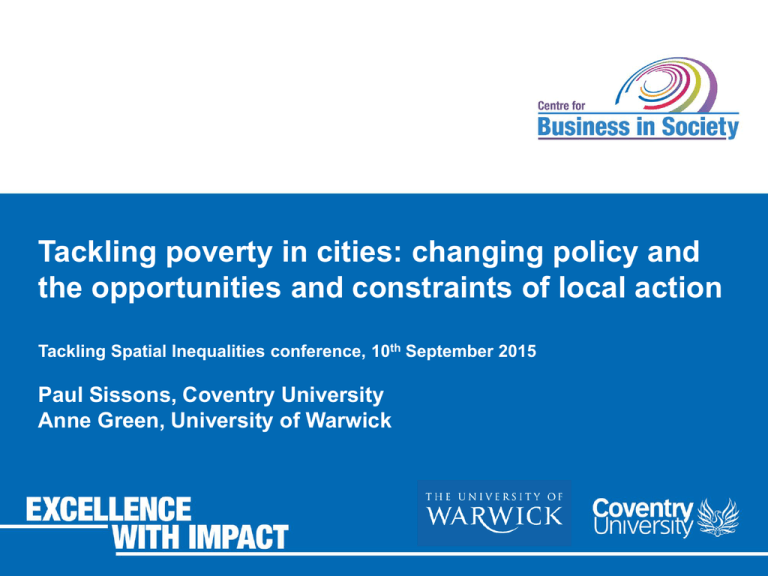Tackling poverty in cities: changing policy and Paul Sissons, Coventry University
advertisement

Tackling poverty in cities: changing policy and the opportunities and constraints of local action Tackling Spatial Inequalities conference, 10th September 2015 Paul Sissons, Coventry University Anne Green, University of Warwick Background 1. Growth of in-work poverty 2. Concerns about job quality, fragmentation of working hours, nonstandard employment 3. Changing national Government approach towards welfare and employment policy 4. Selected devolution to cities – greater responsibility for delivering improved labour market outcomes Outline • Changing policy towards poverty • Local levers for antipoverty policy • The constraints to local anti-poverty policy • Implications for the geography of welfare Draws in part on work funded by Joseph Rowntree Foundation Employment and poverty • Workless households have the highest poverty risk • However, the proportion of poor households where someone works has increased, creating growing concern about in-work poverty. Source: NPI, 2014 The labour market since recession • The value of real wages fell by 10 percent between 2008-2014 – relatively uniform across the wage distribution (but higher for young people) (Machin, 2015) • Increase in (hours) underemployment – just under 3 million workers want additional hours, underemployment rate now around 10 per cent (7 per cent pre-recession) (ONS, 2014) • Growth of zero hours contracts – 2.4 per cent of people in employment (ONS, 2015) • Longer-term concerns about the ‘long-tail’ of low-paid/low-skilled work in the UK (Finegold and Soskice, 1988; Wilson, Hogarth et al., 2003; Wright and Sissons, 2012) National policy for employment and poverty • Shift away from redistribution (2010-2015; 2015-2020): – “from a low-wage, high-tax, high-welfare economy to the higher wage, lower tax, lower welfare country” (Osborne, 2015) – Large cuts in welfare spending (for working-age benefits) – Raising the income tax personal allowance – Introducing a ‘Living Wage’ of £7.20 April 2016; £9 by 2020 • Progress on poverty becoming more dependent on employment trends Emerging devolution of powers to cities • City Deals and Local Growth Deals are part of a gradual (and uneven) transfer of powers towards more localised control of some areas of economic development and skills policy (O’Brien and Pike, 2015) • Some opportunities for LEPs developing policy focused on lowpaid workers – e.g, European Structural and Investment Funds programme (ESIF), including on in-work claimants • Cities therefore assuming increasing responsibility for delivering improved labour market outcomes The employment pathway Local Economy Preemployment Employment entry Staying in work In-work progression Local approaches to addressing poverty – outline PRE-EMPLOYMENT EMPLOYMENT ENTRY STAYING IN WORK INFORMATION, ADVICE AND GUIDANCE IN-WORK PROGRESSION Becoming work-ready: Access to services Personal development advice Careers advice Finance and budgeting Caseworker model Job search and application support: Provision and access to LMI Job search Job match Recruitment channels Caseworker model Careers information and/or advice: Work-focused appraisal LMI: better job opportunities (ILM and ELM – including non-local) Skills transferability Pre-employment (employability): Basic skills Early intervention – including secondary level VET Pre-employment training Volunteering Intermediate Labour Markets Sector Academies Vocational skills: Intermediate Labour Markets Induction Job-specific training (firm-specific) Occupational certification Sector-specific training Apprenticeships Provision of opportunities: Work tasters/ placements Work experience On-site training Provision of opportunities: Procurement Ring-fenced jobs Guaranteed interviews/ jobs Training design and demand identification Flexibility and work design In-work support: Caseworker model TRAINING AND SKILLS Vocational and non-vocational skills development: Job-specific training (firm-specific Linking to employment and not firm-specific) opportunities/ Workplace learning linking to ‘better jobs’ Apprenticeships Vocational and non-vocational skills development: Higher level training (firm-specific and not firm-specific) Apprenticeships Broadening of skills Lifelong learning/ workplace learning EMPLOYER (ENGAGEMENT) In-work support: External ‘key worker’ Mentoring In-work review Flexibility and work design Support to progress: In-work review of opportunities Career ladders Career pathways Flexibility and work design FINANCIAL INCENTIVES Push and pull mechanisms: Increasing earnings: Benefit take-up National Minimum Wage Better-off calculations Wage top-ups Stipends/ training allowances Living Wages Conditionality and sanctions Leeds Wage City subsidies Region (employers) LEP Access to ICT Childcare/care provision Transport availability and cost Health services Community resources Housing services Increasing earnings: National Minimum Wage Wage top-ups Living Wages Increasing earnings: Career ladders to better paid jobs SUPPORT SERVICES / ENABLERS Access to ICT Childcare/care provision Transport availability and cost Health services Community resources Housing services Access to ICT Childcare/care provision Transport availability and cost Health services Community resources Housing services Access to ICT Childcare/care provision Transport availability and cost Health services Community resources Housing services Assessing local opportunities – policy levers – individuals and employers • Strategy and delivery of services – e.g. IAG, skills, LMI • The ‘business case’ - can tailor policy initiatives to demands of specific sectors locally and to addressing specific ‘business case’ issues (e.g. shortage of recruits, skills gaps, etc.) • Targeting funding – e.g. investment in skills • Utilising new developments – e.g. growing apprenticeships • Public sector ‘leading by doing’ – e.g. councils as Living Wage employers • Procurement – e.g. Islington Council and contracting services • Anchor institutions – NHS, Social Landlords, sports clubs and employability; supply-chains? • Exhorting employers to ‘do the right thing’ – Living Wage Campaigns, Fairness Commissions, etc.; encouraging CSR • And, need to ‘join-up’ institutions and actions…. Assessing local constraints – 1) resources and focus • Limited resources and shrinking budgets for economic development and regeneration (Hildreth and Bailey, 2010; Hayman, 2012; Crisp et al, 2014) • Focus tends to be on narrow range of ‘fashionable’ growth sectors (Peck et al, 2013; Sissons and Jones, 2013). Less interest in issues concerning low-paid sectors. – Mirroring national policy in ‘ignoring the bulk of current productive capacity’ (Mayhew and Keep, 2014; 6) – But several low-paid sectors have high projected net employment requirements – 2) labour market change Source: Working Futures projections: 2012-2022 – United Kingdom – 3) the evidence base – 4) Local policy as part of picture Source: Cities, growth and poverty (2014) York: Joseph Rowntree Foundation Austerity and household incomes Source: Resolution Foundation (2015) Spatial implications of recent changes • What implications do changes have for the geography of welfare? (Hamnett, 2009; 2014) - Benefit cuts are hitting some places (much) harder than others (Beatty and Fothergill, 2014) - Some local labour markets are more conducive to improving prospects of low-earners than others - And, the impacts of the Living Wage may also been spatially uneven Conclusions • National policy has shifted away from redistribution to focus on labour market outcomes • At the same time, cities are taking on new responsibilities in relevant policy areas • There are a range of policy levers which they can use to support employment entry and retention locally - Strategy and delivery of services - Utilising business case arguments – skills shortages, turnover, enhancing productivity - Using new developments and procurement - Leading by doing Conclusions (2) • But there are obvious limits to local action - Key areas of policy reside at national level - There are cuts in key budgets - fewer resources for economic development, large reductions to adult skills budget - The local labour market frames what is possible, and recent evidence on the record of employment generation in cities is mixed (Champion and Townsend, 2011; 2013; Lee et al, 2014) Thank You







